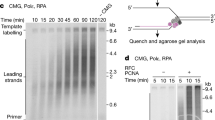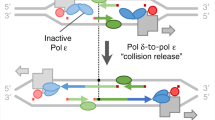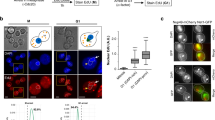Abstract
VARIOUS reports have appeared in the literature concerning the absence of RNA synthesis in metaphase cells. An explanation commonly given is that the condensed or compacted state of chromosomes prohibits DNA transscription1. This explanation is supported by evidence that regions of condensed chromatin in an interphase nucleus are sites of minimal RNA synthesis2. We wish to report some results of recent studies on RNA metabolism during the meiotic cycle which provide additional evidence on the relationship between the physical state of the chromosomes and RNA synthesis. Two features of meiosis are relevant to this report: (1) Cells in early prophase of meiosis (leptotene) synthesize RNA at a much higher rate than those at metaphase3. Indeed, it is probable that no RNA is synthesized during metaphase. (2) At leptotene, chromosomes are in their most extended form; at metaphase, they are in their most contracted form. The biochemical and cytological data are thus consistent with the view that the capacities of chromosomes to transcribe DNA into RNA are inversely related to their degree of condensation. We addressed ourselves to the question of whether in vitro studies of isolated nuclei and chromosomes could yield information on the respective roles of RNA polymerase and template availability in accounting for established observations. Meiotic cells obtained from anthers of Tulipa gesneriana were used in these experiments.
This is a preview of subscription content, access via your institution
Access options
Similar content being viewed by others
References
Monesi, V., J. Cell Biol., 22, 521 (1964). Taylor, J. H., Symp. Cell Physiology of Neoplasia, 547 (University of Texas Press, 1960).
Littau, V. C., Allfrey, V. G., Frenster, J. H., and Mirsky, A. E., Proc. U.S. Nat. Acad. Sci., 52, 93 (1964).
Hotta, Y., and Stern, H. (manuscript submitted).
Chamberlin, M., and Berg, P., Proc. U.S. Nat. Acad. Sci., 48, 81 (1962).
Huang, R. C., and Bonner, J., Proc. U.S. Nat. Acad. Sci., 48, 1216 (1962).
Bodenfreund, E., Fitt, E., and Bendich, A., Nature, 191, 1375 (1961).
Hotta, Y., and Bassel, A., Proc. U.S. Nat. Acad. Sci., 53, 356 (1965).
Author information
Authors and Affiliations
Rights and permissions
About this article
Cite this article
HOTTA, Y., STERN, H. Ribonucleic Acid Polymerase Activity in Extended and Contracted Chromosomes. Nature 210, 1043–1045 (1966). https://doi.org/10.1038/2101043a0
Issue Date:
DOI: https://doi.org/10.1038/2101043a0
This article is cited by
-
Meiosis in Coprinus
Chromosoma (1970)
-
Analysis of Chromatin in Male and Female Mealy Bugs
Nature (1968)
-
RNS- und Protein-Synthese in Puffs isolierter Speicheldr�sen-Chromosomen von Chironomus
Chromosoma (1967)
Comments
By submitting a comment you agree to abide by our Terms and Community Guidelines. If you find something abusive or that does not comply with our terms or guidelines please flag it as inappropriate.



